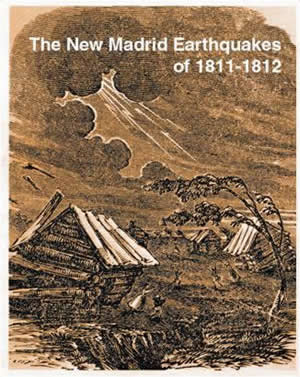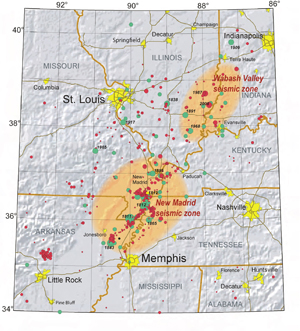
The New Madrid earthquakes were a series of three of the most intense earthquakes in U.S. history, the first of which occurred on December 16, 1811, with major temblors following in January and February of 1812. The first earthquake was so strong that it was felt all over the eastern United States. People were awakened by the shaking as far away as New York City, Washington, D.C., and Charleston, South Carolina.
The seismic events were named for the Mississippi River town of New Madrid, then part of the Louisiana Territory, now within Missouri. The quakes were caused by fault lines situated miles beneath the earth in what is now known as the New Madrid Seismic Zone (NMSZ). To this day, researchers monitor the activity level in the NMSZ, and warn of the potential earthquake threat facing major cities such as St. Louis and Memphis.

1811, December 16, Northeast Arkansas
- 2:15 a.m. local time, the first main shock, magnitude ~7.7
- 7:15 a.m. local time, the “Dawn” Aftershock, magnitude ~7.0
1812, January 23, New Madrid, Missouri
- 9:15 am local time, the second principal shock, magnitude ~7.5
1812, February 7, New Madrid, Missouri
- 3:45 am local time, the third principal earthquake, magnitude ~7.7
To learn more about the potential impact of a major earthquake in the United States, browse our resources.
I.I.I. Resources
Preparedness Tips
External Resources
The Insurance Institute for Business and Home Safety also offers a wealth of information on mitigation and safety:
 The New Madrid earthquakes were a series of three of the most intense earthquakes in U.S. history, the first of which occurred on December 16, 1811, with major temblors following in January and February of 1812. The first earthquake was so strong that it was felt all over the eastern United States. People were awakened by the shaking as far away as New York City, Washington, D.C., and Charleston, South Carolina.
The New Madrid earthquakes were a series of three of the most intense earthquakes in U.S. history, the first of which occurred on December 16, 1811, with major temblors following in January and February of 1812. The first earthquake was so strong that it was felt all over the eastern United States. People were awakened by the shaking as far away as New York City, Washington, D.C., and Charleston, South Carolina.